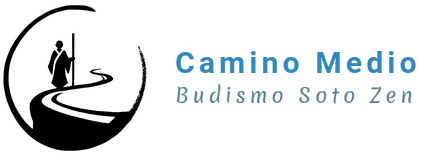⏱️ Estimated reading time: 5 min
What does Soto Zen mean?
The term zen comes from the Chinese word Ch’an, which in turn translates the Sanskrit dhyāna, which means absorption. The school Soto Zen Take your name from the lineage Caodong (Soto) Chinese Ch’an Buddhism. Caodong He transliterated to Japanese as Sharp (Soto), Combining the characters of the names of two great Chinese teachers: Dongshan Liangjie y Caoshan Benji. This tradition emphasizes the direct practice of meditation and the realization of the Budic nature in everyday life.
The Soto Zen School developed in Japan from the thirteenth century with the arrival of the teacher Dogen Zenji, who returned from China deeply influenced by the teachings of Ch’an and founded a form of practice focused on the simple act of sitting: shikantaza.
Currently, The Soto Zen is one of the most practiced forms of Zen Buddhism in the West, characterized by its emphasis on silent meditation, everyday life as a way to awaken, and a non-dual vision of existence.
Characteristics of Buddhism Soto Zen
Soto Zen is direct, sober and deeply committed to experience. It is not based on dogmas or demands beliefs: invites the transformation of consciousness through practice. Awakening is not understood as a future goal, but as the very nature of this moment, as it is.
Unlike other Buddhist traditions, Soto Zen does not emphasize the study of doctrines or resolution of kōan (Meditative). Instead, offers a way of deep simplicity, where the practice consists, literally, in just sit (shikantaza), without clinging to anything, Without pursuing anything, Without rejecting anything.
Dogen expressed it clearly:
“Study Buddhism is to study itself. Studying yourself is forgetting yourself. Forgetting yourself is being one with all stocks.”
How is Soto Zen practiced?
Zazen: Sit without goal
The central practice of Soto Zen is zazen, seated meditation. It is not a technique to obtain special states or a way of relaxing, but a direct expression of the nature of Buddha in this same body. In zazen, We sat down with our backs, The eyes parted, Hands resting in the lap, And we simply let everything be.
There is no object of concentration. There is no method. There is only presence.
This attitude is called shikantaza "I just sit.". It is a complete delivery, No expectation or calculation, To the experience of this moment.
Although this simplicity is the heart of practice, In our community we follow a didactic process that, progressively, is approaching each person to that direct experience. Through personalized accompaniment, Introduction sessions, retreats and shared study, We are revealing the layers of the mind that simply prevent being, Until practice can bloom naturally.
Life as practice
Zazen It is not limited to the cushion. In the Soto tradition, All action can be zazen: cook, walk, clean, Scuchar, sleep. That's why, Community life in a dojo or Zen temple is deeply ritualized, Not as an empty formalism, but as a way of integrating full attention into each gesture.
Examples of these practices include:
- Oryoki: ritual form of eating in silence with special bowls.
- Find: Conscious community work as a form of practice.
- Kinhin: meditation walking in full attention.
- Ceremonies: collective expression of gratitude and interdependence.
Practice without goals
Unlike other schools that propose scales of spiritual progress, Soto Zen insists that Practice is already the expression of lighting. It is not practiced to become Buddha; it is practiced from The nature of Buddha. As Dogen said:
"Practice and realization are not separated."
Soto Zen History
The Soto school was founded in Japan in the thirteenth century by Dogen Zenji After his return from China. Disappointed with formal practices without spirit that he observed in Japan, Dogen brought a deeply renewed teaching with him: The road is the very practice.
Next to Keizan Jokin, who helped expand school throughout Japan, Dogen left a legacy of texts such as Shobogenzo (The Treasury of the True Eye of Dharma), They are still a guide for thousands of practitioners today.
In the twentieth century, teachers like Shunryu Suzuki, Taisen Deshimaru o Kodo Sawaki They took the Soto Zen to the West, where it flourished in new forms, both monastic and secular.
What differentiates it from other Zen schools?
While the Rinzai school emphasizes the use of KOANS and the dynamic confrontation with a teacher, Soto Zen emphasizes a practice without artifice, without trying to reach anything. This difference is not an opposition, but a diversity of approaches.
Soto Zen is often perceived as quieter, contemplative, non-interventionist: It is fully trusting that the truth is revealed when we stop interfering.
Is a teacher necessary?
The Soto tradition argues that the relationship with a teacher is fundamental. The teacher is not a guru or an infallible being, but a person who has traveled the way and can offer accompaniment, Correct subtle errors and transmit the living spirit of practice.
The Soto Zen Camino Medio Community
In the Soto Zen Camino Medio Community, We follow this spirit. We practice zazen daily, We meet in retreats, And we take care of the simple and shared life. Our teaching is based on the Japanese Soto tradition, But it's alive, rooted in our culture and open to those who sincerely want to explore the path of awakening.
We offer:
- Zazen diary (face -to -face and online)
- Introduction sessions
- Seasonal retreats
- Ceremonies, votes and training
- Spaces for the study of Dharma
Our practice is not an escape from life, but a way of living more clearly, compassion and freedom in the midst of it.
How to start?
You can start sitting at home five minutes a day. Or you can approach a dojo, Where you will find a guide, Community and a practice with roots. No matter your age, religion, Personal history. You just need to stop, Breathe and look honestly.
Zazen is to sit like who sits with your best friend: No need for words, only presence.

